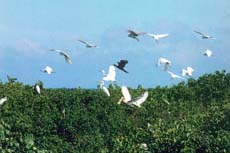People often talk about the Mekong Delta for its floating markets of small wooden boats filled to the gunwales with vegetables or fruit, canals in the shade of water coconuts, old houses and pagodas. Bac Lieu Province has the waterways but it also has a fascinating history. A lot of old architecture and anecdotes have survived.
 |
| The memorial house where musician Cao Van Lau lived with his wife in Bac Lieu Province, before his parents forced them to split |
Bac Lieu Province is about 295 kilometers from HCMC. It shares its border with Can Tho City and Soc Trang Province to the north, the East Sea to the south, Ca Mau and Kien Giang provinces to the west.
Bac Lieu is the convergence of three lines of culture - Kinh, Khmer and Chinese, so tourists can discover their diverse customs and culture.
Bac Lieu is the birthplace of a famous traditional opera piece called Da Co Hoai Lang (Awaiting One’s Husband) written by musician Cao Van Lau in the nineteenth century. The opera tells of a wife who awaits her husband’s return from the battlefield as she listens to the sounds of war drums. At the time when Lau wrote it, his parents had forced him to leave his wife because she couldn’t bare him a son. Although the subject matter is markedly different, the song represented the composer’s emotional turmoil and love for his wife.
 |
|
Bac Lieu Bird Sanctuary |
Tourists can visit the house where Cao Van Lau lived with his wife. There is a large bronze statue and photos of him and many of his possessions on display.
The next stop should be Bac Lieu Bird Sanctuary in Hiep Thanh Commune, Bac Lieu Town, which is home to water birds mainly teal, stork, heron, night heron and cormorant. Huge flocks of birds leave the wetlands early in the morning and return to their nests in the sanctuary in the evening, as the night birds fly off to feed. The bird sanctuary is a salt-marsh ecosystem.
Another stop is Bac Lieu ancient longan garden that was planted about 200 years ago when the first residents came here to farm. Now, the garden covers hundreds of hectares, supplying hundred tons of longans to the market every year. The longan trees are over hundred years old and their fruits are sweet.
The sunset on nearby Ganh Hao sea is also an amazing sight.
 |
|
Xiem Can Pagoda |
Xiem Can Pagoda is renowned for its Angkor-like architecture with clusters of decorated towers and tombs and bas-reliefs presenting Buddhist culture in harmony with Indian civilization. Another work is Vinh Hung tower, also known as Luc Hien or Bhah Dhat tower that was discovered in 1911 and is recognized as a heritage site in the South.
In May 1990 archeologists determined that the tower was different to other Cham towers as the brick work is so tight fitting. It is rectangular and 9.3 meters high. Because of neglect the top and front collapsed and the area has overgrown with wild grass and lianas.
During an excavation in 1990, archaeologists found a 2.6-meter wooden pillar made in 928 as well as a head and hand of a bronze statue of Buddha, dating back to the first centuries BC. This confirmed that Buddhism was widespread in the Mekong Delta at that time.
Archeologists also discovered popular Hindu objects of worship, such as Linga, Yoni, Somasutra pipe (holy water pipe) and a bronze statue of goddess Brahma.
The tower was then rebuilt and decorated as it is on Wednesday, in ancient style in harmony with contemporary decoration.
Pilgrims around the country flock to the tower especially in January to pray for good health and good luck.